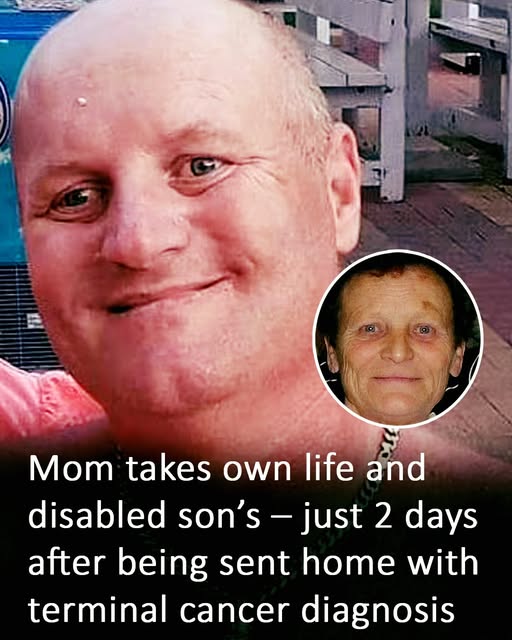In 2021, a tragic story unfolded in Middlesborough, England, where 67-year-old Shirley Nunn and her 50-year-old son Steven were found dead in their home. What initially seemed like a quiet, sorrowful passing has since come to light as a preventable tragedy—one that was shaped by a combination of personal hardship, systemic failure, and an overwhelming sense of hopelessness.

In October 2021, Shirley received life-altering news: she was diagnosed with terminal cancer. Doctors confirmed that the disease had advanced to the point where recovery was no longer possible. The cancer, which began in her lungs, had spread aggressively to her brain, spine, and pelvis. This devastating diagnosis would be difficult for anyone to handle, but for Shirley, her concerns stretched far beyond her own life. Her greatest worry was her son, Steven—how would he manage without her?
Steven had lived a life full of challenges. At the age of 11, he suffered a severe accident that left him in a coma and caused permanent brain damage. Though doctors performed multiple surgeries to save his life, the trauma left him with lifelong disabilities. Steven was diagnosed with cerebral palsy and epilepsy, and he struggled with significant learning difficulties, mobility issues, and emotional regulation. From that moment on, Shirley stepped into the role of his full-time caregiver.
After Shirley’s husband passed away from cancer, she became Steven’s only consistent source of support. While adult social care services had been involved in Steven’s case since 2005, it was Shirley who provided daily, hands-on care. She was not only his mother but his advocate, caretaker, and emotional anchor. She remained committed to his wellbeing through decades of struggle, dedicating her entire life to his needs.
When Shirley was diagnosed with terminal cancer, her main concern wasn’t her own suffering—it was Steven’s future. As her health deteriorated, she continued to take care of him the best she could, despite the pain and physical limitations she faced. Both the hospital and Shirley made arrangements for her to receive palliative care at home, and she expressed a strong desire to die in the comfort of her own surroundings.
But behind the scenes, Shirley was experiencing profound emotional turmoil. A Domestic Homicide Review later revealed that Shirley was battling depression and had expressed suicidal thoughts. The report described her as “loving and caring,” noting that she was far more concerned about her son’s fate than her own rapidly declining health. She had broken down in tears during consultations, devastated by the thought of leaving Steven without a caregiver. Her emotional pain was deep, and her vulnerability was evident to those around her.
In October 2021, Shirley was hospitalized again due to complications related to her cancer. Staff at the hospital were informed that she preferred to return home for her final days, and arrangements for palliative care were underway. Tragically, just two days after she was discharged, Shirley’s sister called the police. Both Shirley and Steven were found dead in their home. The date marked exactly two years since her husband Paul had died of cancer, adding another layer of heartbreak to an already devastating event.
The investigation that followed revealed missed opportunities that could have changed the outcome. Authorities failed to recognize the severity of Shirley’s psychological state, and vital support systems were either delayed or absent altogether. The report concluded that the urgency of her mental health needs was not fully understood or acted upon by professionals involved in her care.
The review went on to highlight how Shirley had always put Steven’s needs ahead of her own. It appeared that, in the absence of adequate support, she felt there was no viable option for her son’s continued care. The conclusion was as chilling as it was heartbreaking: Shirley may have made the devastating decision to end both their lives out of desperation, driven by a belief that no one else would care for Steven the way she did.
This tragic case brings forth critical questions about how society treats individuals with terminal illnesses and those who care for vulnerable dependents. When a person like Shirley—clearly loving, devoted, and overwhelmed—falls through the cracks of our healthcare and social support systems, it raises serious concerns about how we prioritize mental health and caregiver assistance. Are we doing enough to support those who give everything of themselves to care for others? What more could have been done to ensure Shirley didn’t feel like she had no way out?
Caregivers like Shirley often operate in the shadows, giving their all to support loved ones while receiving minimal help themselves. Their sacrifices are immense, but their suffering is often invisible. This case highlights the desperate need for improved mental health services, more proactive caregiver support, and early intervention strategies when red flags appear. Had someone fully grasped the depth of Shirley’s emotional distress and the impossible position she felt trapped in, there might have been a chance to prevent this double tragedy.
Shirley’s love for Steven was unwavering. Her entire life revolved around his wellbeing, and her final days were consumed with worry about his future. That love, however, was met with silence from a system that failed to act in time. Her story is not just one of personal loss—it’s a reflection of a broader societal issue that demands urgent attention.
As we reflect on this heartbreaking story, we must ask ourselves how many more caregivers are suffering in silence. What steps can be taken to ensure no one else feels so abandoned that death seems like the only way out? The answers won’t come easily, but acknowledging these failures is the first step toward building a more compassionate, responsive, and supportive system for those who need it most.





